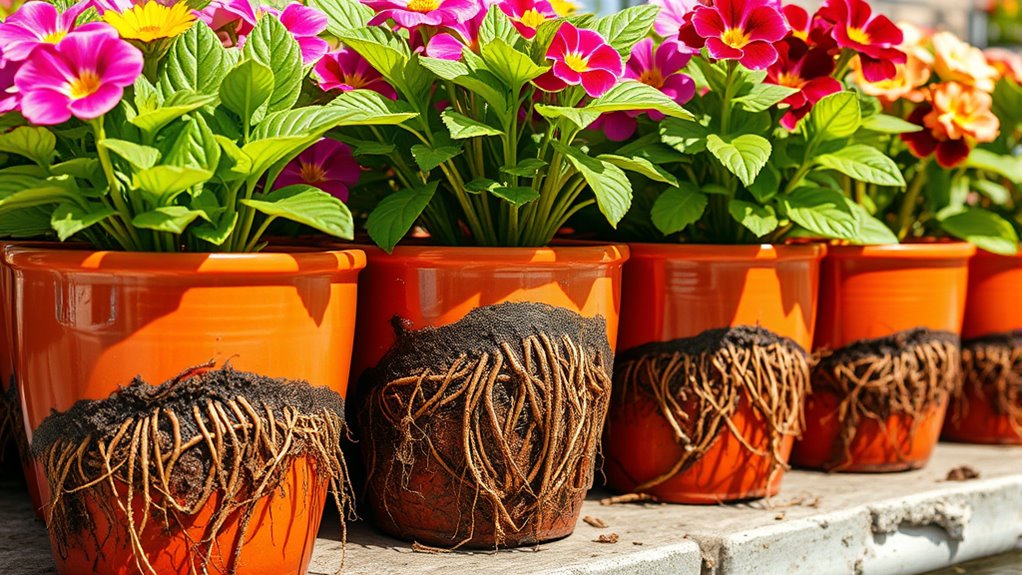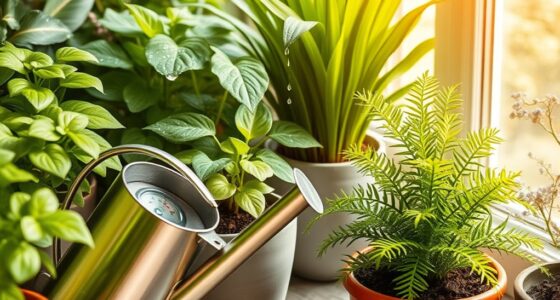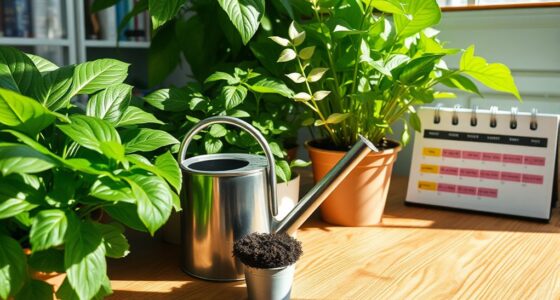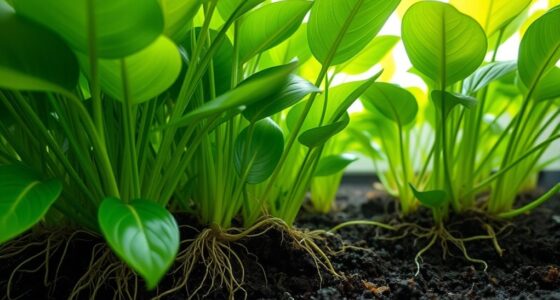Keeping your plant rootbound on purpose can actually boost flowering by signaling stress that encourages earlier and more vibrant blooms. Using tight pots mimics natural conditions where resources are limited, triggering the plant to focus on reproduction. This method can lead to an earlier, fuller display of flowers. However, it requires careful management and timing. To discover how to do this safely and effectively, you’ll find strategies that turn a stress into a flowering advantage.
Key Takeaways
- Rootbound conditions signal stress that can stimulate plants to flower earlier or more abundantly.
- Temporarily rootbound pots encourage vibrant blooms by mimicking natural resource-limited environments.
- Controlled root confinement boosts flowering without permanent root restriction, enhancing visual appeal.
- Proper management ensures plants benefit from rootbound stress without excessive damage or health issues.
- Transplanting after peak flowering helps plants recover and continue healthy growth.
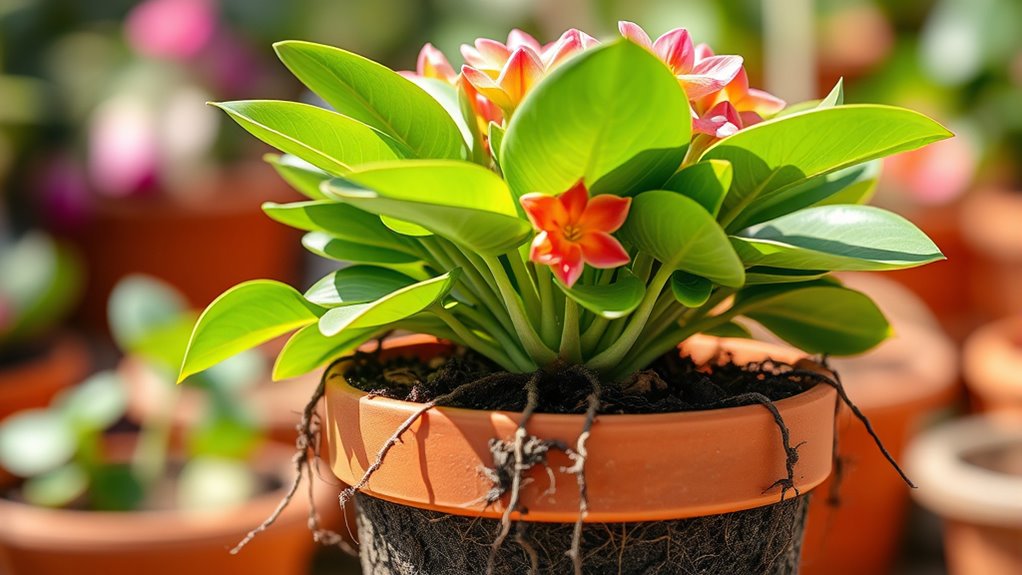
Have you ever wondered why some gardeners intentionally keep their plants rootbound? It might seem counterintuitive since most of us believe that giving roots plenty of space encourages healthy growth. However, experienced gardeners sometimes purposefully restrict roots to achieve specific results, especially when it comes to flowering. When a plant becomes rootbound, its roots circle tightly within the pot, signaling the plant to focus its energy on reproductive processes rather than vegetative growth. This natural stress triggers the plant to produce more flowers or fruit as a survival mechanism, mimicking conditions in the wild where resources are limited.
By intentionally keeping a plant rootbound, you can stimulate earlier or more abundant flowering. When roots are crowded, they signal to the plant that its environment is constrained, prompting it to accelerate its reproductive cycle to guarantee species survival. For flowering plants like orchids, roses, or certain annuals, this can mean a burst of vibrant blooms sooner than expected. The key here is timing and control—you’re not letting the plant stay rootbound indefinitely but encouraging a temporary condition that boosts flowering. Once the plant reaches the desired flowering stage, you can repot it into a larger container, giving it room to grow further.
Keeping plants temporarily rootbound can boost flowering and bloom earlier with proper timing and control.
This method works because of how plants respond to stress. Root confinement limits water and nutrient uptake, which in turn causes the plant to allocate more energy toward flowering and seed production. It’s similar to how some plants in the wild produce flowers quickly when they’re in a tight spot, aiming to reproduce before conditions worsen. As a gardener, you’re harnessing this natural response to enhance your garden’s visual appeal. It’s important to monitor your plant closely, guaranteeing it doesn’t become too stressed or damaged. The goal isn’t to harm the plant but to create a controlled environment that encourages flowering.
Additionally, proper watering and fertilization are essential to helping a rootbound plant thrive during this period, as these practices ensure the plant receives the nutrients it needs despite limited root space. While it might seem risky, intentionally rootbound plants can be healthier and more vibrant if managed correctly. Keep an eye on watering and fertilization, as these will influence how well the plant copes with its restricted roots. Once flowering peaks, you can transplant the plant into a larger pot, allowing it to recover and continue growing robustly. This technique isn’t for every plant or every gardener, but understanding the underlying principles allows you to experiment and potentially unlock more blooms from your favorite plants. It’s a strategic approach that taps into plant resilience, turning what appears to be a limitation into a tool for vibrant, abundant flowering.
Frequently Asked Questions
Can Rootbound Plants Recover Without Repotting?
Yes, your rootbound plants can recover without repotting if you take specific steps. You should water them thoroughly to encourage root growth, prune or trim the roots to stimulate new growth, and guarantee they receive proper nutrients. Providing consistent watering and fertilization helps them recover faster. However, keep an eye on their progress, and consider repotting if they don’t improve, as this can offer more space for healthy development.
What Are the Signs of Over-Rooted Plants?
You’ll notice over-rooted plants when their roots circle densely around the pot’s edges or emerge from drainage holes. The plant may show stunted growth, yellowing leaves, or wilting despite proper watering. You might also see reduced flowering or fruiting, indicating the roots are cramped. If you observe these signs, consider repotting or trimming roots to help your plant thrive, ensuring it has enough space to grow healthily.
How Often Should I Intentionally Rootbound My Plants?
Think of it like tuning a guitar—you don’t want it too tight or too loose. You should intentionally rootbound your plants when they’ve outgrown their pots, usually every couple of growth cycles or when roots circle the pot’s edges. Keep an eye out for signs such as slowed growth or water runoff issues, and then decide if a snug, controlled root environment might just be the boost your plant needs for flowering.
Does Rootbinding Affect Plant Nutrient Uptake?
Yes, rootbinding can affect your plant’s nutrient uptake. When roots are tightly packed, they struggle to absorb essential nutrients efficiently, which may stunt growth or reduce flowering. However, some growers intentionally rootbound plants to boost flowering, as it stresses the plant and encourages blooming. Keep an eye on your plant’s health, and adjust watering or fertilizing as needed to support nutrient absorption in tightly bound roots.
Are Certain Plant Species Better Suited for Rootbinding?
Are some plants naturally better suited for rootbinding? Yes, certain species like succulents, cacti, and some orchids handle tight roots well because they’re adapted to dry or constrained environments. You might wonder if all plants thrive in small pots—most don’t. Knowing your plant’s needs helps you choose the right container size, encouraging healthy growth and flowering. So, select species that tolerate or even benefit from root confinement to optimize your gardening success.
Conclusion
So, next time you see your plant snug in its pot, remember it’s like a seed waiting for its moment to break free. Sometimes, a tight space isn’t a trap but a cocoon, sparking growth and transformation. Embrace the rootbound stage as a symbol of potential—where strength is forged in confinement, ready to burst forth into blooming beauty. Trust the process, and watch your plant flourish beyond what you could imagine.

